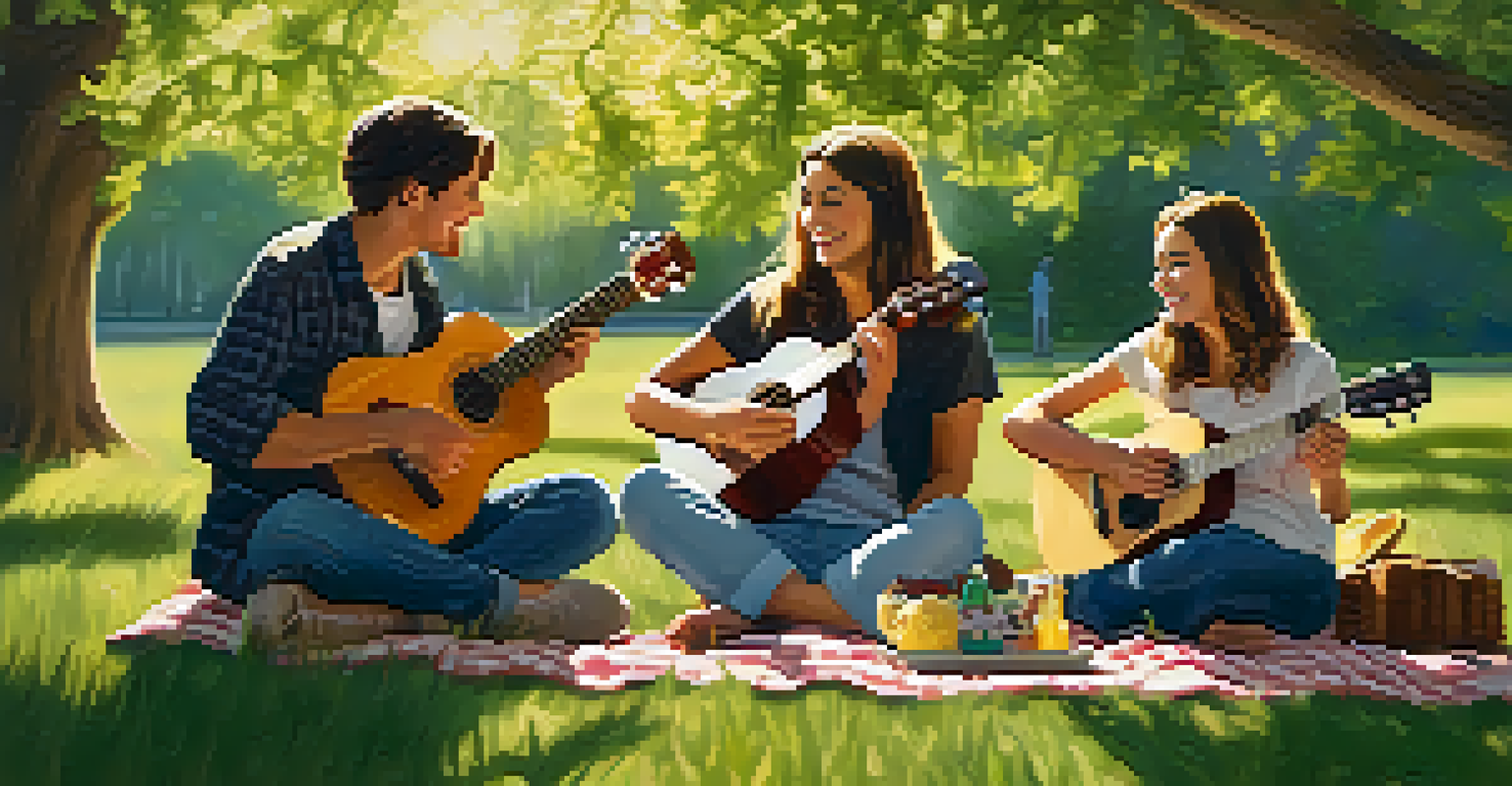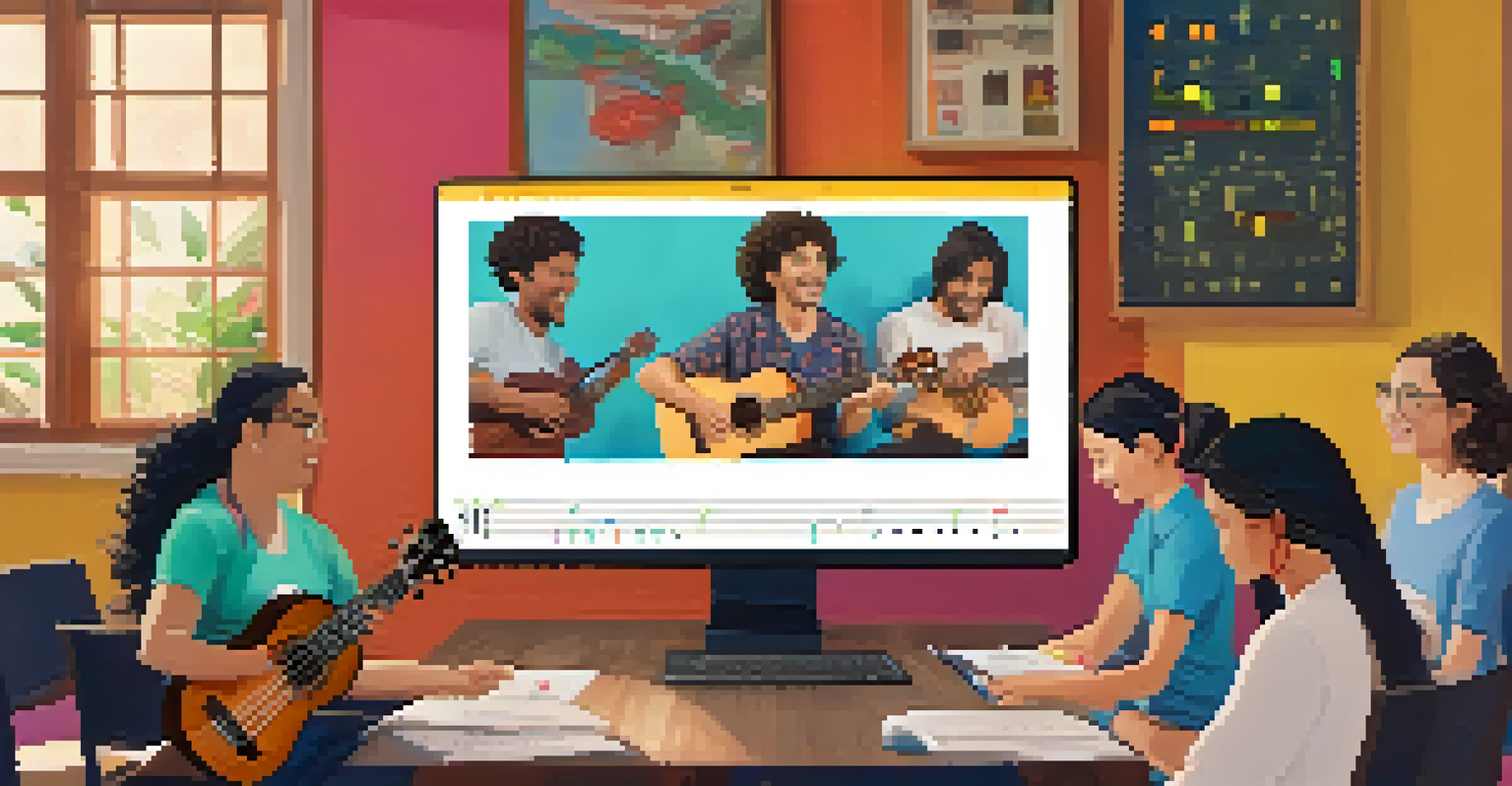Engaging Your Audience with Interactive Ukulele Lessons

Understanding the Power of Interactive Learning
Interactive learning transforms traditional education by involving students directly in the process. This approach encourages active participation rather than passive absorption of information. For example, when students play along with a song, they're not just listening; they're creating music, which deepens their understanding and retention.
Tell me and I forget, teach me and I remember, involve me and I learn.
Engaging your audience through interaction also fosters a sense of community. When learners share their progress, challenges, and successes, they build connections with one another. This aspect is particularly vital for ukulele lessons, where collaboration can enhance the learning experience.
Ultimately, interactive learning cultivates a more enjoyable atmosphere, leading to higher motivation and better outcomes. When students feel invested in their education, they are more likely to practice and improve their skills, making the journey of learning the ukulele more rewarding.
Incorporating Technology into Ukulele Lessons
Technology can enhance the learning experience by providing tools that make lessons more interactive. Apps and online platforms allow students to track their progress, access tutorials, and connect with other learners. For instance, a metronome app can help students practice timing while playing along with their favorite songs.

Video conferencing tools enable real-time interaction between instructors and students, regardless of their locations. This accessibility means that you can reach a wider audience and cater to various skill levels. Imagine hosting a live ukulele jam session where everyone plays together, regardless of whether they’re in the same room.
Interactive Learning Boosts Engagement
Involving students directly in the learning process fosters active participation and a sense of community.
Additionally, utilizing platforms like YouTube for instructional videos allows students to learn at their own pace. They can pause, rewind, or replay sections as needed, making it easier to grasp challenging concepts. This flexibility encourages learners to take ownership of their education, enhancing their engagement.
Designing Engaging Lesson Plans
An engaging ukulele lesson plan should balance instruction with interactive elements. Begin with a warm-up that encourages participation, such as a group strumming exercise. This not only warms up the fingers but also sets a collaborative tone for the lesson.
Creativity is intelligence having fun.
Incorporating games or challenges can keep the energy high and make learning fun. For example, you might have a 'play what you hear' game where students mimic a melody. This approach not only reinforces listening skills but also adds an element of friendly competition.
Lastly, ensure that your lesson plans are adaptable to different skill levels. This might mean offering advanced options for seasoned players while providing foundational support for beginners. By catering to diverse needs, you’ll keep everyone engaged and eager to learn.
Using Group Activities to Foster Community
Group activities are a fantastic way to build camaraderie among students. When learners come together to play ukulele, they create a supportive environment that encourages sharing and collaboration. Consider organizing group songs where everyone contributes a part, fostering teamwork.
Encouraging peer feedback is another effective strategy. After a practice session, have students share their thoughts on each other’s playing. This not only helps them improve but also builds trust and respect within the group.
Technology Enhances Ukulele Lessons
Utilizing apps and online platforms allows for personalized learning experiences and real-time collaboration.
Creating a community around your lessons can lead to lasting friendships and connections. When students feel like they belong, they are more likely to continue their musical journey and support one another along the way.
Encouraging Student Creativity
Encouraging creativity is essential in making ukulele lessons engaging. Allow students to experiment with their own arrangements of songs or even create original compositions. This freedom to express themselves musically can be incredibly empowering.
You might introduce songwriting exercises where students collaborate to write a song together. This not only enhances their understanding of music theory but also fosters a sense of ownership and pride in their work. Plus, it’s a great way to showcase their talents in a fun way.
Creativity thrives in a supportive environment. Celebrate all efforts, whether they’re polished performances or rough drafts, to nurture a culture where students feel safe to explore and innovate.
Utilizing Feedback to Enhance Learning
Feedback is a crucial component of the learning process, especially in music education. Constructive criticism helps students identify areas for improvement and reinforces their strengths. Create a culture where feedback is seen as a positive tool for growth rather than a criticism.
Consider implementing a feedback loop where students can express what they enjoy or find challenging during lessons. This open communication allows you to tailor your teaching approach to better meet their needs while keeping them engaged.
Creativity and Community Are Key
Encouraging creativity through group activities and feedback builds a supportive environment that motivates students.
Additionally, celebrate progress, no matter how small. Recognizing achievements boosts morale and encourages students to strive for their goals, making them more eager to participate in future lessons.
Creating a Fun Learning Environment
A fun learning environment is key to keeping students engaged in their ukulele lessons. Incorporate humor and light-hearted moments to make the experience enjoyable. A funny anecdote or a light-hearted competition can break the ice and create a welcoming atmosphere.
Decorating your teaching space with musical themes or encouraging students to personalize their instruments can also enhance the experience. A visually stimulating environment can inspire creativity and excitement about learning.

Remember that students often learn best when they’re having fun. By prioritizing a joyful atmosphere, you create a space where students feel comfortable, leading to better retention and a deeper love for music.